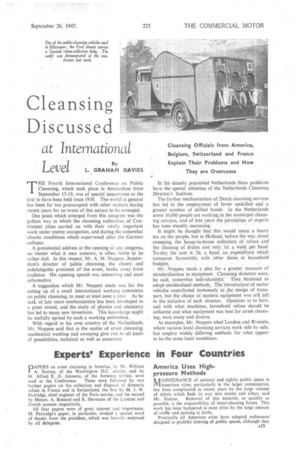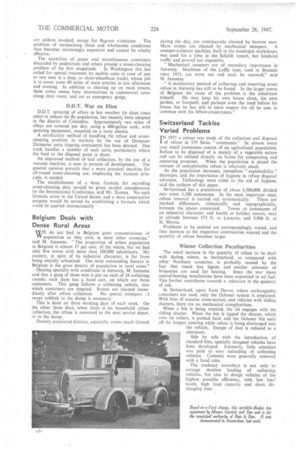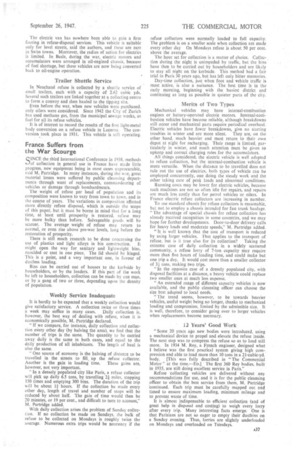Experts' Experience in Four Countries
Page 51

Page 52

Page 55

If you've noticed an error in this article please click here to report it so we can fix it.
PAPERS on street cleansing in America, by Mr. William A. Xanten, of the Washington D.C. &mice, and by M. Alfred E. D. Janssens, of the Antwerp service, were
read at the Conference. These were followed by two further papers on the collection and disposal of domestic refuse in France and in Switzerland, the first by M. I. W. Partridge, chief engineer of the Paris service, and the second by Messrs. A. Bossard and R. Hermann of the Lucerne and Zurich systems respectively.
All four papers were of great interest and importance. M. Partridge's paper, in particular, evoked a special word of thanks from the president, which was heartily endorsed by all delegates. America Uses Highpressure Methods lUAINTENANCE of sanitary and sightly public space in MArnerican cities, particularly in the larger communities, has been complicated in recent years by the large volume of debris which finds its way into streets and alleys, said
Mr. Xanten. Removal of this material, as quickly as possible, is the responsibility of street-cleaning forces. This work has been hampered in most cities by the large amount of traffic and parking at kerbs.
Practically all American cities have adopted ordinances' designed to prohibit littering of public spaces, although they are seldom invoked, except for flagrant violations. The problem of maintaining clean and wholesome conditions thus becomes increasingly expensive and cannot be wholly effective.
The quantities of paper and miscellaneous containers discarded by pedestrians and others present a street-cleaning problem of the first magnitude. In Washington this has called for special treatment by mobile units (a crew of one or two men in a Jeep, or short-wheelbase truck), whose job is to cover some 40 miles of main arteries in late afternoon and evening. In addition to clearing up on main streets, these crews sweep busy intersections in commercial areas along their route, and act as emergency gangs.
D.D.T. War on Flies
D.D.T. spraying of alleys in hot weather (in slum' areas only) to reduce the fly population, has recently been adopted in the district of Colombia. Approximately two miles of alleys are covered per day, using a 400-gallon tank, with spraying equipment, mounted on a lorry chassis.
A satisfactory method of handling the refuse and streetcleaning problem in markets by the use of Dempster Dumpster units (tipping containers) has been devised. One truck handles a number of such units, particularly where the haul to the disposal point is short.
An improved method of leaf collection, by the use of a tacuum machine, is now in process of development. The general opinion prevails that a more practical machine for all-round street-cleaning use; employing the vacuum principle, is needed.
The establishment of a basic formula for recording street-cleaning data should be given careful consideration by the International Conference, said Mr. Xanten. No such formula exists in the United States, and a Most constructive purpose would be served by establishing a formula Which could be applied internationally
Belgium Deals with Dense Rural Areas lyx. do not 'find in Belgium great concentrations of
17 population as they, exist in most other countries," said M. Janssens. "The proportion of urban population in Belgium is almost 37 per cent, of the whole, but we find Only five towns with more than 100,000 inhabitants. My country, in spite of its industrial character, is far from being entirely urbanized. The most outstanding feature in Belgium is the great density of population in rural areas."
Dealing specially with conditions in Antwerp, M. Janssens said that a gang of three men is put on each of 24 collecting rounds; each team has a hand cart, on which are three containers. This gang follows a collecting vehicle, into which containers are emptied. Streets are cleaned imme
diately after refuse collection. No special transport I f swept rubbish to the dump is necessary.
This is done on three working days of each week. On the other three days, when there is no household refuse zoilection, the refuse is conveyed to the next service depot, or to the dump.
Densely populated districts, especially streets much littered during the day, -are continuously cleaned by barrow men.
Main streets are' cleaned by mechanical sweepers. A sweeper-collector machine, built in the municipal workshops, was used for a time in the Scheldt tunnel, but hindered traffic and proved too expensive.
"Mechanical sweepers are of secondary importance in Antwerp. Machines of the Laffly type, used in Brussels since 1913, are worn out and must be renewed," said M. Janssens.
"A satisfactory method of collecting and removing street refuse in Antwerp has still to be found. In the larger towns of Belgium the cause of the problem is the inhabitant himself. He may keep his own house clean, his own garden, or footpath, and perhaps even the road before his house, but he has still to learn respect for all he uses in common with his fellow-countrymen."
Switzerland Tackles Varied Problems I N 1937 a census • was made of the collection and disposal of refuse in 379 Swiss "communes." In almost every case small communes consist of an agricultural population. Refuse to be disposed of is mainly of a vegetable nature and can be utilized directly on farms for composting and
manuring purposes. When the population is mixed the amount of unexploitable refuse is relatively small.
As the population increases, immediate " exploitability " decreases, and the importance of hygiene in refuse disposal advances. Technology must come to the aid of hygiene, said the authors of this paper.
Switzerland has a population of about 4,500,000, divided into some 3,100 communes. In the most important ones, refuse removal is carried out systematically. There are marked differences, climatically and topographically, between the places concerned. Towns or communes of an industrial character, and health or holiday resorts, vary in altitude between 673 ft. at Locarno, and 5,906 ft. at St. Moritz.
Problems to be tackled are correspondingly varied, and they increase as the respective communities expand and the quantity of refuse becomes larger Winter Collection Peculiarities
The small increase in the quantity of refuse to be dealt with during winter, in Switzerland, as compared with other Northern countries, is probably caused by the fact that much less lignite and smaller amounts of briquettes are used for heating. Since the war many central-heating installations have been converted to oil fuel. This further contributes towards a reduction in the quantity of ash.
In Switzerland, apart from Davos, where exchangeable containers are used, only the Ochsner system is employed. With bins of circular cross-section, and vehicles with sliding shutters, there are no mechanical complications.
When a bin is being emptied, the lid engages with the sliding shutter. When the bin is tipped the shutter, which runs on rollers, is pushed back and the Ochsner bin seals off the hopper opening while refuse is being discharged into the vehicle. Escape of dust is reduced to a minimum.
Side by side with the introduction of standard bins, specially designed vehicles have been developed. Formerly, little attention was paid to easy unloading of collecting vehicles. Contents were generally removed with a hand rake.
The tendency nowadays is not only to arrange dustless loading of collecting vehicles, but also to design vehicles 'of the highest possible efficiency, with low lowt levels, high load capacity and short discharging time. The electric van has nowhere been able to gain a firm footing in refuse-disposal services. This vehicle is suitable only for level streets, said the authors, and these are rare in Swiss towns. Moreover, the radius of action for electrics is limited. In Basle, during the war, electric motors and accumulators were arranged in oil-engined chassis, because of fuel shortage, but these vehicles are now being converted hack to oil-engine operation.
Trailer Shuttle Service In Neuchatel refuse is collected by a shuttle service of small trailers, each• with a capacity of 2.62 cubic yds. Several such trailers are linked together at a collecting centre to form a convoy and then hauled to the tipping site.
Even before the war, when new vehicles were purchased, only oilers were considered. Since 1942 the City of Zurich has used methane gas, from the municipal sewage works, as fuel for all its refuse vehicles.
• It is of interest to record the results of the first light-metal body conversion on a refuse vehicle in Lucerne. The conversion took place in 1931. This vehicle is still operating.
France Suffers from the War Scourge SINCE the third International Conference in 1938, methods of collection in general use in France have made little progress, new equipment being in most cases unprocurable, said M. Partridge. In many instances, during the war, great material losses were suffered by public cleansing departments through want of replacements, commandeering of vehicles or damage through bombardments.
The weight of refuse per head of population aod its composition were known to vary from town to town, and in the course of years. The variations in composition affected more directly refuse disposal, which is outside the scope of this paper, but it must be borne in mind that for a long time, at least until prosperity is restored, refuse may be more bulky than before. Salvageable goods will be scarcer. The average weight of refuse may return to normal, or even rise above pre-war levels, long before the restoration of prosperity.
There is still much research to be done concerning the use of plastics and light alloys in bin construction. It might open the way for sanitary and lightweight bins, moulded or cast in one piece. The lid should he hinged. This is a point, and a very important one, in favour of dustless loading.
Bins can be carried out of houses to the kerbside by householders, or by the loaders. If this part of the work be left to householders, collection can be made by one man, or by e gang of two or three, depending upon the density of Population.
. Weekly Service Inadequate
It is hardly to be expected that a weekly collection would give satisfactory, service. A collection twice or three times a week may suffice in many cases. Daily collection is, however, the best way of dealing with refuse, when it is economically possible, M. Partridge declared.
"If we compare, for instance, daily collection and collection every other day (by halving the area), we find that the number of trips is the same. The quantity to be carried away daily is the same in both cases, and equal to the daily production of all inhabitants. The length of haul is also the same.
One source of economy is the belying of distance to be travelled in the streets to fill, up the refuse collector.
Another is the gain in loading time. These gains are, however, not very important.
"In a densely populated city like Paris, a refuse collector will pick up daily 6.5 tons, by travelling 2i miles, stopping 150 times and emptying 300 bins. The duration of the trip will be about l hours. If the collection be made every other day, length of travel and number of stops will be reduced by about half. The gain of time would then be 20 minutes, or 19 per cent., and difficult to turn to account," M. Partridge added.
With daily collection arises the ieroblem of Sunday collection. If no collection be made on Sundays, the bulk of refuse to be collected on Mondays is roughly twice the average. Numerous extra trips would be necessary if the refuse collectors were normally loaded to full capacity. The problem is on a smaller scale when collection are made every other day On Mondays refuse is about 50 per cent. above the average.
The hour set for collection is a matter of choice. Collection during the night is unimpeded by traffic, but the bins have then to be carried out by householders and are likely to stay all night on the kerbside. This method had a fair trial in Paris 30 years ago, but has left only bitter memories.
Day-time collection, just when foot and vehicle traffic is most active,' is also a nuisance. The best time is in the early morning, beginning with the busiest district and continuing as long as possible in quieter parts of the city.
Merits of Two Types
Mechanical vehicles may have internal-combustioe engines or battery-operated electric motors. Internal-cornbustion vehicles have become reliable, although breakdowns still occur and mechanical parts require periodical overhaul. Electric vehicles have fewer breakdowns, give no starting troubles in winter and are more silent. They are, on the other hand. much heavier and must return to their own depot at night for recharging. Their range is limited, particularly in winter, and much attention must be given to upkeep and correct charging rates for the accumulators.
All things considered, the electric vehicle is well adapted to refuse collection, but the internal-combustion vehicle is more versatile. When the distance to be travelled does not rule out the use of electrics, both types of vehicle can be employed concurrently, one doing the steady work and the other taking care of peak loads and abnormal conditions.
Running costs may be lower for electric vehicles, because such machines are not so often idle for repairs, and repairs are much less costly than for petrol vehicles or oilers. In France electric refuse collectors are increasing in number.
To use standard chassis for refuse collectors is reasonable, but not to employ a chassis intended for fast trunk haulage. "The advantage of special chassis for refuse collection has already received recognition in some countries, and we may hope for further developments. Door-to-door delivery calls for heavy loads and moderate speeds," M. Partridge added.
"It is well known that the cost of transport is reduced by using larger vehicles. That applies to the transport of
refuse, but is it true also for its collection? Taking the extreme case of daily collection in a widely scattered community, a refuse lorry of 7-ton capacity may require more than five hours of loading time, and could make but one trip a day. It would cost more than a smaller collector of 3i tons, making two trips.
"In the opposite case of a densely populated city, with disposal facilities at a distance, a heavy vehicle could replace two smaller ones at much less expense.
" An extended range of different capacity vehicles is now available, and the public cleansing officer can choose the size best adapted to local needs.
" The trend seems, however, to be towards heavier vehicles, useful weight being no longer, thanks to mechanical loading and compression, limited by the admissible size. It is well, therefore, to consider going over to larger vehicles when replacements become necessary.
• 12 Years' Good Work "Some 20 years ago new bodies were introduced, using a mechanical device to propel and elevate the refuse inside. The next step was to compress the refuse so as to load still more. In 1934 M. Rey, a French engineer, designed what I believe was the first practical system giving high corne pression and able to load more than 10 tons in a 21-cubic-yd.
body. [This was fully described in "The Commercial Motor" at the time.---ED.] The first 360 Rey bodies, built in 1935, are still doing excellent service in Paris."
Refuse 'collecting vehicles are delivered without any recommendations for use, and it is for the public cleansing officer to obtain the best service from them, M, Partridge 'continued. Each trip must be carefully mapped out and timed to ensure maximum loading, minimum mileage and to prevent waste of time.
It is almost indispensable to efficient collection (and of great help in disposal and costing) to weigh every lorry after every trip. Many interesting facts emerge. One is that Parisians are not so eager to empty their dustbins on a Sunday evening. Thus, lorries are slightly underloaded on Mondays and overloaded on Tuesdays.




















































































